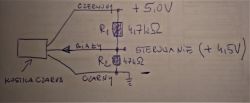Hi,
Let me start by thanking the author - thanks to you, I managed to diagnose and initially "repair" my tank (Peugeot 308, 1.6 BHDI from 2014).
After disassembling the tank, I diagnosed damaged fluid level and heating plate temperature sensors - resistances of several hundred ohms, voltage measurement tests give illogical results. The reason for the damage is Adblue inside this "cassette with a heating plate". I replaced the level sensor with a divider with two resistors (4.7 and 47k), and I inserted a 10k thermistor into the rubber corrugated tube.
I also have some observations that I decided to share (unfortunately it was very long 😊):
- the resistances of the heating circuits of the pump group controlled together (the "green" circuit - heating the pump, the "yellow" circuit - heating the solenoid valve, the "blue" circuit - heating the urea accumulator, the "white" circuit - heating the elbow where the urea exits the tank) I have different resistances than the author of the post ( Unfortunately, I lost the sheet of paper with the values written down). The resultant resistance of all circuits in my case is about 7 ohms (the author of the post had 11.6) - this does not cause any problems for now
- the resistances of the heating circuits of all hoses and the plate are the same
- pump cables: after briefly connecting the black plus, green and yellow minus, the pump pumps urea and fills the battery (opposite as in one of the posts). The pump works in both directions. The urea suction and pump operation are audible after turning off the engine - it appears when the hot engine is turned off and the SCR system is operational.
- the thermistor inserted about 10 cm into the corrugated rubber cable in the tank reacts only minimally to the heating of the plate. After a few minutes of heating (connected for a short time), you can hear crackling noises inside the tank - about 10 liters of ADBLUE have been filled.
- in the diagbox I have the parameters: urea pipe heating power and tank heating power in %, which suggests that there is at least PWM and not ON/OFF - based on which thermometer it is controlled, I have no idea. I also believe that since ADBLUE does not like temperatures above 30 degrees, this tile should not reach higher temperatures
- I drove about 300 km in a few days with the tank removed. I did not see any message such as 1100 km to start lock. Only after starting the car or after a few km, the messages engine fault, URERA fault, SERVICE and UREA warning lights appear. The messages only appeared once per startup. Errors in the engine controller: SCR absent, CAN communication error with SCR and low urea pressure (I don't remember the codes). Theoretically you can drive like this, but on the other hand I am not sure that somewhere in the background it is not counting the kilometers until the start lock.
- after installing the "repaired" tank, additional errors appeared: incorrect urea level, other SCR faults and the message "starting blocked after 1100 km" refreshed every few minutes. It didn't clear itself (I drove for one day, about 60 km). I suspect that they were stored somewhere in the tank controller, and since the ECU did not disconnect it because it diagnosed itself correctly after the "repair", they were sent.
- I performed the DENOX system reinitialization procedure in diagbox (or something similar). After this procedure, it does not report any messages immediately. The errors in the ECU then need to be deleted, they have not appeared again for several days.
- personally, I think that while a fire or burnout of the tank is quite unlikely (I have a thermistor inserted into this corrugated pipe), the problem may arise when this board reaches a temperature above 30 degrees and, in my opinion, it will degrade ADBLUE.
- I'll drive for a while and if there are still no errors, I'm going to put a heating cable with a thermistor glued into the tank (I'll probably replace the shunt, because 100W won't fit.) I'm also considering using an infrared heating foil (unfortunately, there's not enough space for 100W either) or lying with a few watt light bulb and a shunt swap. I also thought about cutting out a part of the tank (the one inside the chamber with the pump, directly under the pump), then replacing the thermistor, sealing the plate, do not glue it, just screw on the tank dome. This will, of course, mean that the space where the pump is originally located and the rest will be flooded with ADBLUE, so everything that is there will have to be moved outside the tank - in my opinion, it's doable, but it's a lot of work.


